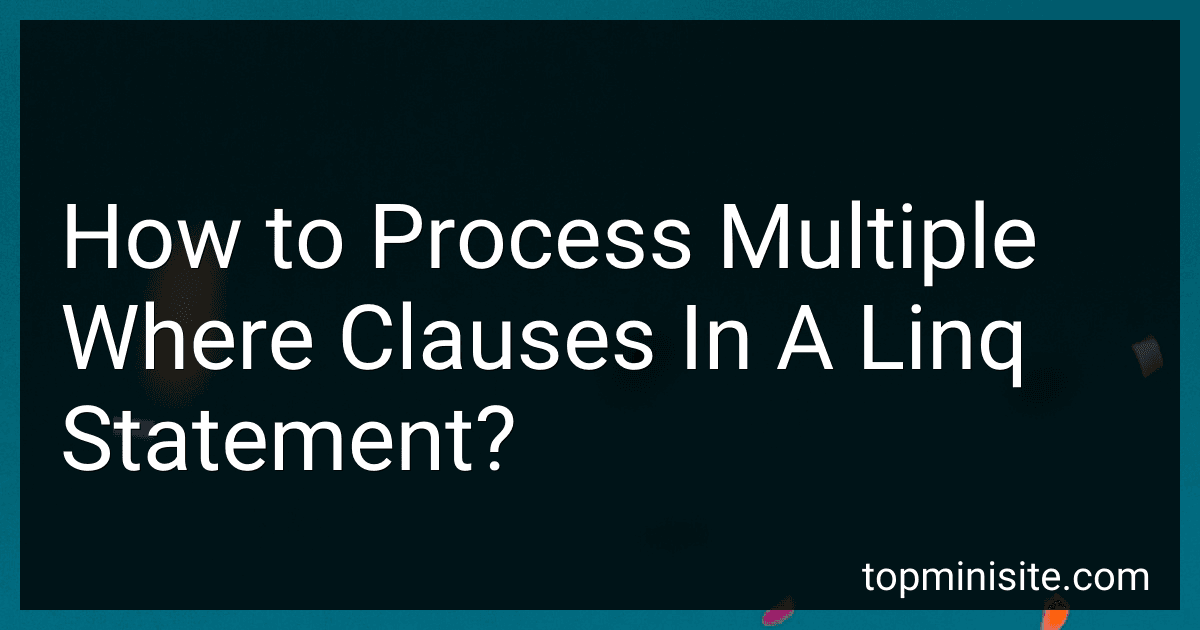Posts (page 14)
-
 8 min readTo filter a LINQ query by date, you typically work with collections where the items have a DateTime property. You first identify the DateTime property you wish to filter. Then, use a LINQ query with a Where clause specifying the date comparison. Your predicate inside the Where method can compare the DateTime property to a specific date or range of dates using relational operators such as ==, !=, <, >, <=, and >=.
8 min readTo filter a LINQ query by date, you typically work with collections where the items have a DateTime property. You first identify the DateTime property you wish to filter. Then, use a LINQ query with a Where clause specifying the date comparison. Your predicate inside the Where method can compare the DateTime property to a specific date or range of dates using relational operators such as ==, !=, <, >, <=, and >=.
-
 6 min readHandling null values in a LINQ subquery involves ensuring that the subquery does not produce an error if it encounters null values. This typically requires the use of null-coalescing operators or conditional checks. In LINQ, you can employ the ?? operator to provide a default value if a null is encountered or use the let keyword to pre-compute values that handle nulls gracefully.
6 min readHandling null values in a LINQ subquery involves ensuring that the subquery does not produce an error if it encounters null values. This typically requires the use of null-coalescing operators or conditional checks. In LINQ, you can employ the ?? operator to provide a default value if a null is encountered or use the let keyword to pre-compute values that handle nulls gracefully.
-
 8 min readIn LINQ, the foreach loop is used to iterate over a collection of elements that you retrieve using a LINQ query. After writing the LINQ query, which might involve operations like where, select, or orderBy, you execute it and often store the results in an IEnumerable<T>. You can then use a foreach loop to process each element of the collection individually. This is useful when you want to apply some operation to each element or accumulate results.
8 min readIn LINQ, the foreach loop is used to iterate over a collection of elements that you retrieve using a LINQ query. After writing the LINQ query, which might involve operations like where, select, or orderBy, you execute it and often store the results in an IEnumerable<T>. You can then use a foreach loop to process each element of the collection individually. This is useful when you want to apply some operation to each element or accumulate results.
-
 10 min readTo implement a dynamic "where" clause in LINQ, you can utilize the concept of building queries incrementally based on certain conditions. This is often necessary when you want to apply filters conditionally based on user input or other criteria at runtime. One common approach is to start with a base query and then append additional conditions using conditional logic.
10 min readTo implement a dynamic "where" clause in LINQ, you can utilize the concept of building queries incrementally based on certain conditions. This is often necessary when you want to apply filters conditionally based on user input or other criteria at runtime. One common approach is to start with a base query and then append additional conditions using conditional logic.
-
 10 min readIn a LINQ query, you can use conditional logic similar to an if statement by using the ternary conditional operator (?:) within the query. This operator allows you to return one of two values depending on the evaluation of a Boolean expression. In the context of a LINQ query, you can incorporate this logic into a select clause to compute different results based on a condition. Alternatively, you can apply conditional logic within a where clause to filter elements based on a condition.
10 min readIn a LINQ query, you can use conditional logic similar to an if statement by using the ternary conditional operator (?:) within the query. This operator allows you to return one of two values depending on the evaluation of a Boolean expression. In the context of a LINQ query, you can incorporate this logic into a select clause to compute different results based on a condition. Alternatively, you can apply conditional logic within a where clause to filter elements based on a condition.
-
 10 min readTo merge several arrays in a list using LINQ in C#, you can utilize the SelectMany method. This method is particularly effective for flattening collections of collections. If you have a list where each element is an array, you can apply SelectMany to project each array into a single sequence. This effectively merges all arrays into one continuous sequence.
10 min readTo merge several arrays in a list using LINQ in C#, you can utilize the SelectMany method. This method is particularly effective for flattening collections of collections. If you have a list where each element is an array, you can apply SelectMany to project each array into a single sequence. This effectively merges all arrays into one continuous sequence.
-
 8 min readConverting an SQL query to a LINQ query involves understanding the similarities and differences between SQL and LINQ syntax. First, identify the data source, like a table in SQL, which corresponds to a collection or a context-based property in LINQ. Next, translate the SELECT statement by using the select keyword in LINQ, which projects the desired columns or data. In SQL's FROM clause, you specify the table to query, which maps to the from keyword in LINQ to specify the data source.
8 min readConverting an SQL query to a LINQ query involves understanding the similarities and differences between SQL and LINQ syntax. First, identify the data source, like a table in SQL, which corresponds to a collection or a context-based property in LINQ. Next, translate the SELECT statement by using the select keyword in LINQ, which projects the desired columns or data. In SQL's FROM clause, you specify the table to query, which maps to the from keyword in LINQ to specify the data source.
-
 13 min readTo perform a distinct operation on a column using LINQ, you generally use the Distinct() method. If you want to retrieve distinct values from a particular column in a collection, you can use the Select() method to project that column and then apply Distinct() on the resulting sequence. For example, if you have a collection of objects and you want to find distinct values of a specific property, you can first select that property and then use Distinct() to eliminate duplicates.
13 min readTo perform a distinct operation on a column using LINQ, you generally use the Distinct() method. If you want to retrieve distinct values from a particular column in a collection, you can use the Select() method to project that column and then apply Distinct() on the resulting sequence. For example, if you have a collection of objects and you want to find distinct values of a specific property, you can first select that property and then use Distinct() to eliminate duplicates.
-
 11 min readTo get a custom object from a list using LINQ, you can utilize various methods such as FirstOrDefault, Where, SingleOrDefault, or Select. Typically, you'll define a query or method chain that specifies the criteria for selecting the desired object. The most direct approach is FirstOrDefault, which retrieves the first element that satisfies a specified condition.Here's a general outline using FirstOrDefault:Define your list: Ensure you have a list of objects to work with.
11 min readTo get a custom object from a list using LINQ, you can utilize various methods such as FirstOrDefault, Where, SingleOrDefault, or Select. Typically, you'll define a query or method chain that specifies the criteria for selecting the desired object. The most direct approach is FirstOrDefault, which retrieves the first element that satisfies a specified condition.Here's a general outline using FirstOrDefault:Define your list: Ensure you have a list of objects to work with.
-
 8 min readIn LINQ, you can define variables within a query using the let keyword. This allows you to store the result of a sub-expression and use it later in the query, improving readability and performance by avoiding the recalculation of values. The let keyword introduces a range variable that represents the result of the expression on the right side of the keyword. The syntax is typically used within a LINQ query to simplify complex queries by breaking them down into more manageable parts.
8 min readIn LINQ, you can define variables within a query using the let keyword. This allows you to store the result of a sub-expression and use it later in the query, improving readability and performance by avoiding the recalculation of values. The let keyword introduces a range variable that represents the result of the expression on the right side of the keyword. The syntax is typically used within a LINQ query to simplify complex queries by breaking them down into more manageable parts.
-
 10 min readTo add sort direction when using LINQ for SQL, you can use the OrderBy, OrderByDescending, ThenBy, and ThenByDescending methods. These methods allow you to specify the sort field and direction for your query results. If you need to sort data in ascending order, you can use OrderBy and ThenBy. For descending order, use OrderByDescending and ThenByDescending.
10 min readTo add sort direction when using LINQ for SQL, you can use the OrderBy, OrderByDescending, ThenBy, and ThenByDescending methods. These methods allow you to specify the sort field and direction for your query results. If you need to sort data in ascending order, you can use OrderBy and ThenBy. For descending order, use OrderByDescending and ThenByDescending.
-
 10 min readIn LINQ, you can process multiple where clauses by chaining them together. Each where clause filters the sequence based on a given condition, and by using multiple where clauses, you can apply several filters to your data. The result is equivalent to using a single where clause with a compound logical expression that combines the conditions using logical operators like &&.
10 min readIn LINQ, you can process multiple where clauses by chaining them together. Each where clause filters the sequence based on a given condition, and by using multiple where clauses, you can apply several filters to your data. The result is equivalent to using a single where clause with a compound logical expression that combines the conditions using logical operators like &&.